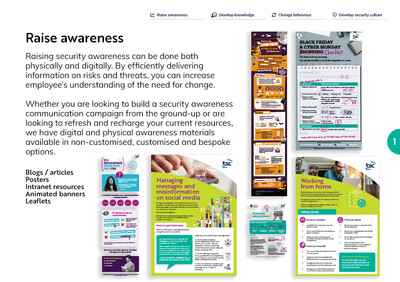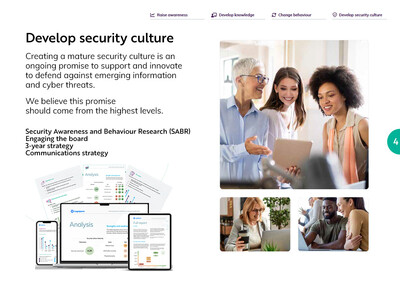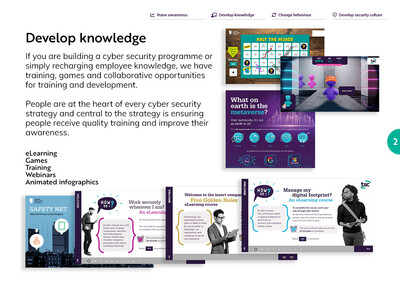
- Ransomware
- 8 min read

Establishing a robust cyber security culture has become an indispensable aspect of safeguarding sensitive data and protecting organisations from evolving cyber threats.
As Chief Information Security Officers (CISOs) and individuals passionate about cyber security, understanding the major components of a cyber security culture is crucial for creating a secure and resilient environment.
In this article, we will explore the key elements that constitute a strong cyber security culture. By recognising and nurturing these components, you can foster a security-conscious organisation, training your employees to be better equipped to face common threats and emerging challenges.
Education and knowledge development is the cornerstone of a cyber security culture. Regular and comprehensive training programs are essential to equip employees with the knowledge and skills to identify and respond to common cyber threats like phishing and ransomware effectively. Use phishing simulations, workshops, games with leaderboards, team activities and physical materials in the office on topics such as data protection, social media, and physical security. A well-informed workforce that has supportive materials available to them in an easy-to-access way and are constantly refreshed on the shifting landscape will serve as a formidable defence against cyber-attacks.

An effective cyber security culture starts at the top. CISOs and top-level executives must demonstrate unwavering commitment to cyber security to see the same sentiment trickle down the company. Leading by example, executives and board members should actively engage in security practices, support training initiatives, and allocate resources to bolster the organisation's security posture. When leadership shows commitment, their employees will show commitment. It can be difficult to explain cyber security issues and initiatives to board members, which is why it is helpful to speak their language and contextualise your issues in a way they can understand. If this expertise does not exist internally, organisations like TSC, who have been doing this for over 20 years, can simplify the process for you.

Establishing and communicating clear security policies and procedures are critical for shaping the behaviour of employees. These policies should cover a wide range of topics, such as password management, data classification, and incident reporting protocols. Regular updates and accessible documentation ensure that employees are always aware of the latest security guidelines. Your organisation must also keep policies and protocols up to date for compliance reasons with the level of cybercrime fines increasing exponentially over the last year.

A cyber security culture thrives on continuous improvement. Cyber threats and cyber criminals do not stand still, so your culture must change and shift alongside the space. Implementing robust monitoring systems allows organisations to detect potential security breaches in real-time but also pinpoint gaps in the security armour that need to be addressed with training and awareness campaigns. Regular analysis of incident data and security metrics will help identify patterns and weaknesses, enabling proactive responses to emerging threats and informing your own work.
A strong cyber security culture encourages employees to report potential security incidents promptly. Establishing a well-defined incident response plan empowers the organisation to handle security breaches efficiently and minimise their impact. Often employees are not reporting security breaches because they are either unaware one has taken place, or they are afraid of the ramifications that will fall on them. You must encourage a blame-free reporting culture to foster an environment where employees feel comfortable reporting suspicious activities without fear of retribution.
Open channels of communication between different departments and teams are essential for fostering a cohesive cyber security culture. Encourage collaboration among IT, HR, legal, and other relevant departments to ensure that cyber security practices are integrated into all aspects of the organisation. You must also open a direct line of communication to every department and accept that they will all learn and retain information at various levels depending on the communication channel used. For instance, one department may be particularly receptive to in-person team activities whilst another may prefer more individualised engaging eLearning courses. Or, you could have the front-office client-facing employees asking for clear desk, clear screen training whilst your warehouse operatives ask about IoT (Internet of Things) security.
Cyber threats constantly evolve, making continuous training and awareness initiatives vital. Stay up to date with the latest trends and vulnerabilities, and tailor training programs accordingly. Regularly remind employees of their role in maintaining a secure environment and celebrate security successes. For most organisations, internal resources that support continuous training and take advantage of cyber security dates and months may be lacking due to budget and time. This is where collaborating with an external security awareness and training partner can really help to maximise your training and development programme. Furthermore, it can often be difficult to spot the gaps in your security when you are in the eye of the storm. Bringing in external objective eyes could clear the skies and illuminate you to security issues you never even realised existed.
Recognising and rewarding employees for their contributions to the cyber security culture reinforces positive behaviour. Highlight exemplary security practices and encourage others to follow suit. Public acknowledgment of security-conscious employees motivates the workforce to remain vigilant and proactive. Employees need reasons to care about cyber security. We encourage board engagement and personal development for this very reason but recognising security champions and advocates is just as effective to create a competitive yet supportive culture.
Incorporating these major components into your organisation's cyber security culture is vital for building a resilient and secure environment.
Leadership commitment, employee training, clear policies, continuous monitoring, and incident response are among the foundational pillars of a successful cyber security culture.
By fostering a collaborative and proactive approach, CISOs can create a workforce that is fully engaged, security-conscious, and capable of effectively mitigating cyber risks. Embrace these components and let your organisation's cyber security culture become a powerful shield.
If you would like information about how The Security Company can help you to formulate a cyber security training and awareness program for your organisation and how we help support security leaders in setting up a fresh cyber security awareness framework ... please contact our Head of Business Development and Sales, Jenny Mandley.
The Security Company's vast library of customised and non-customised products and services are tailored for small, medium and large organisations and are available in a variety of languages. We also offer bespoke solutions for organisations that desire training and awareness materials built from the ground up.



© The Security Company (International) Limited 2025
Office One, 1 Coldbath Square, London, EC1R 5HL, UK
Company registration No: 3703393
VAT No: 385 8337 51


